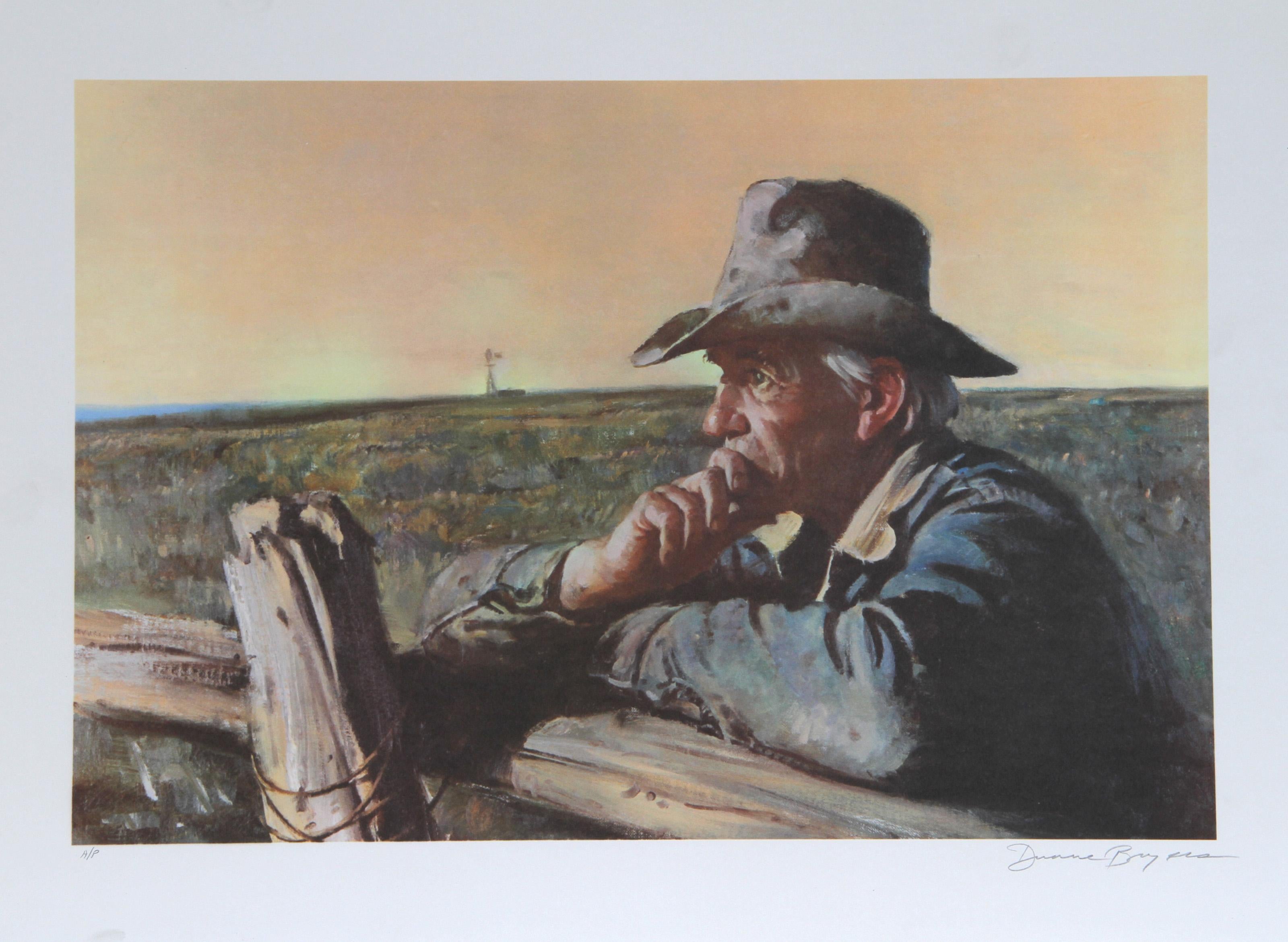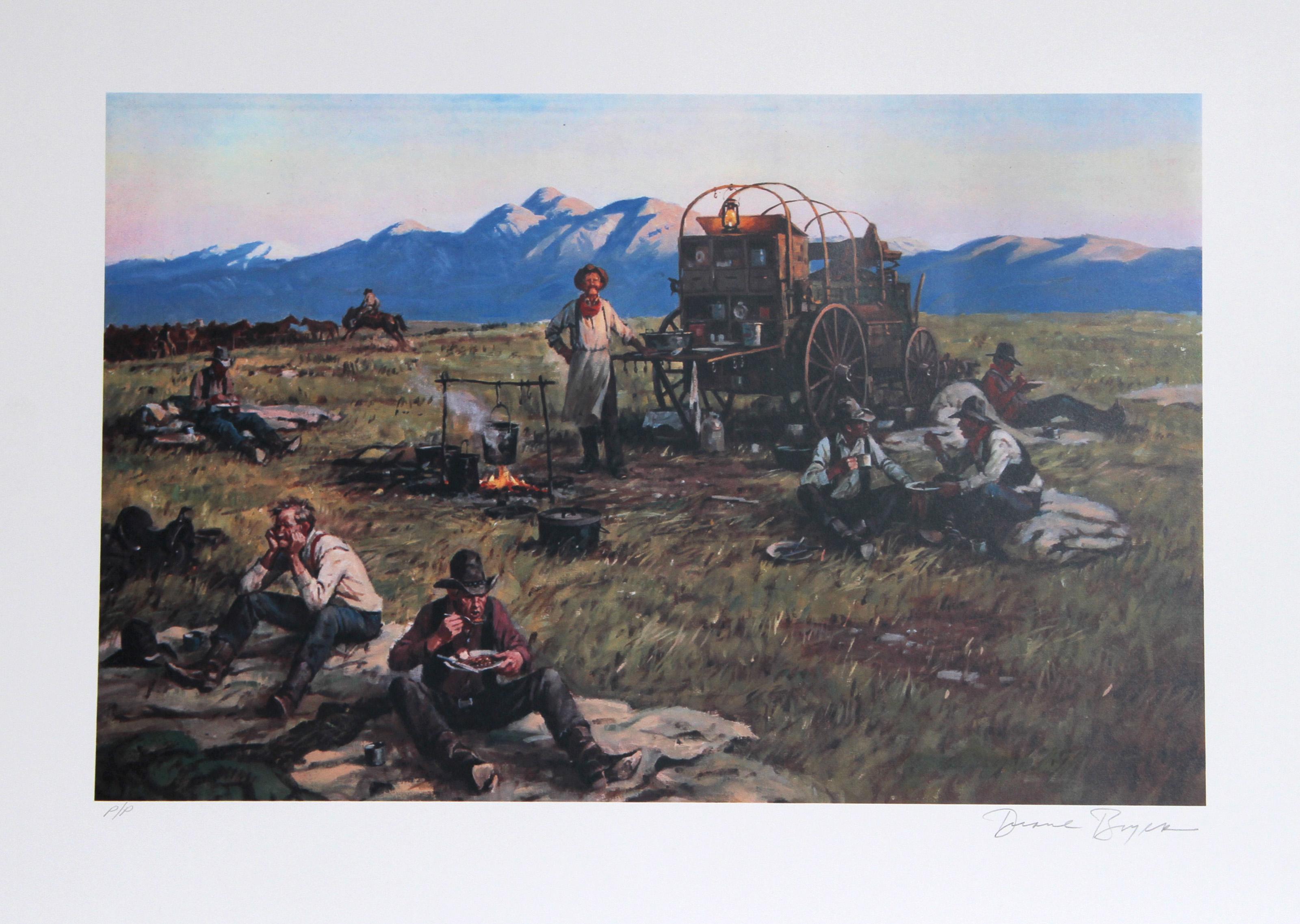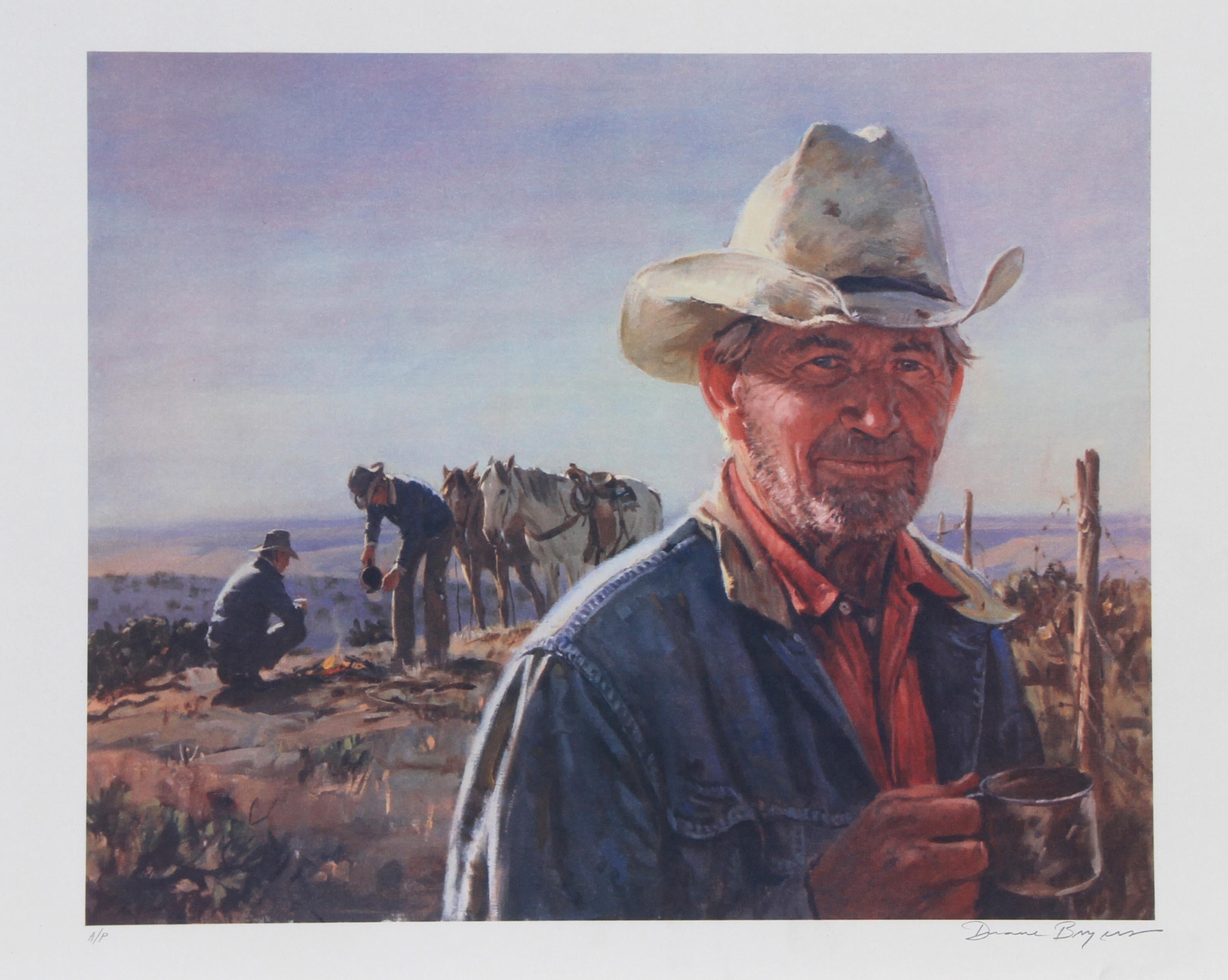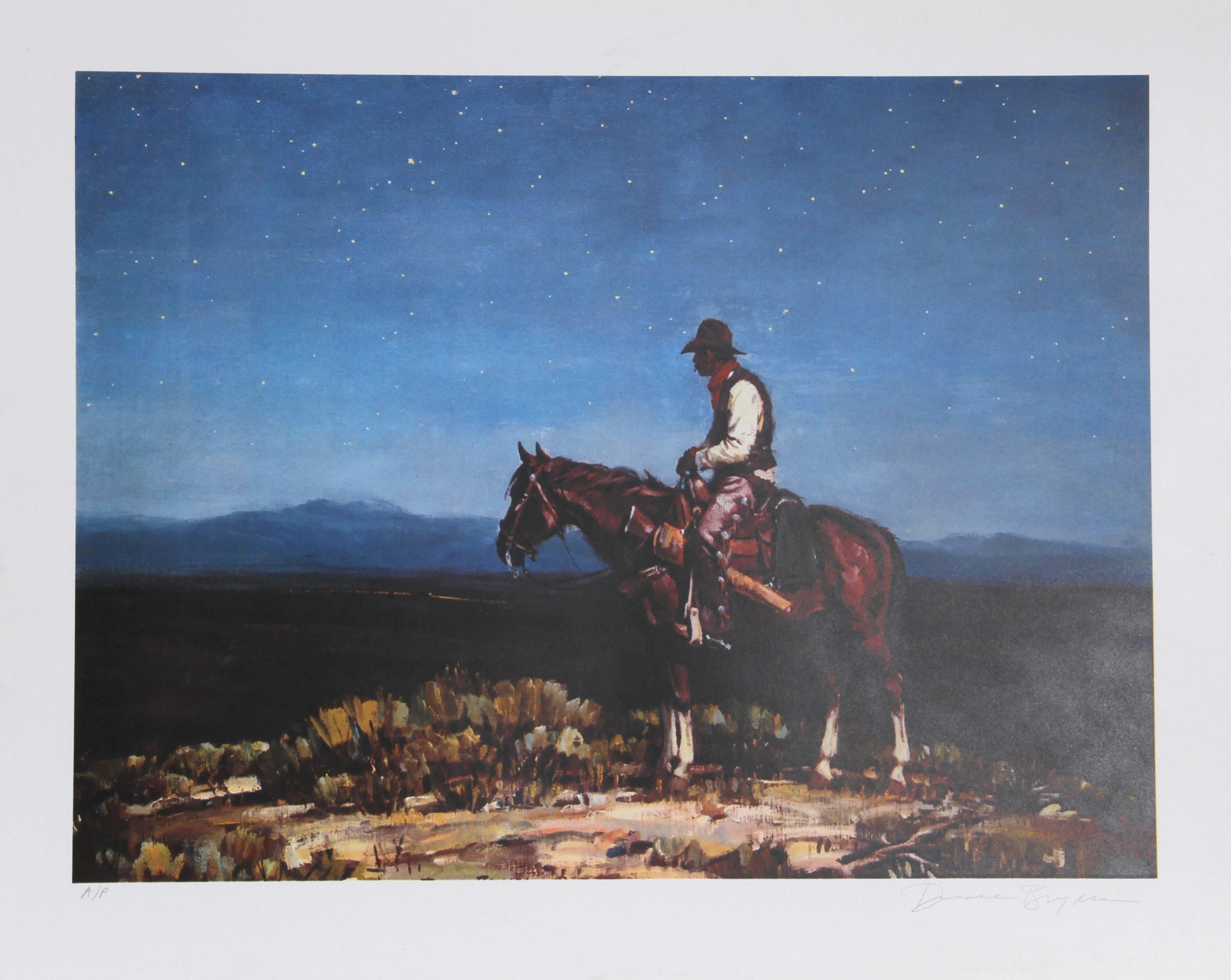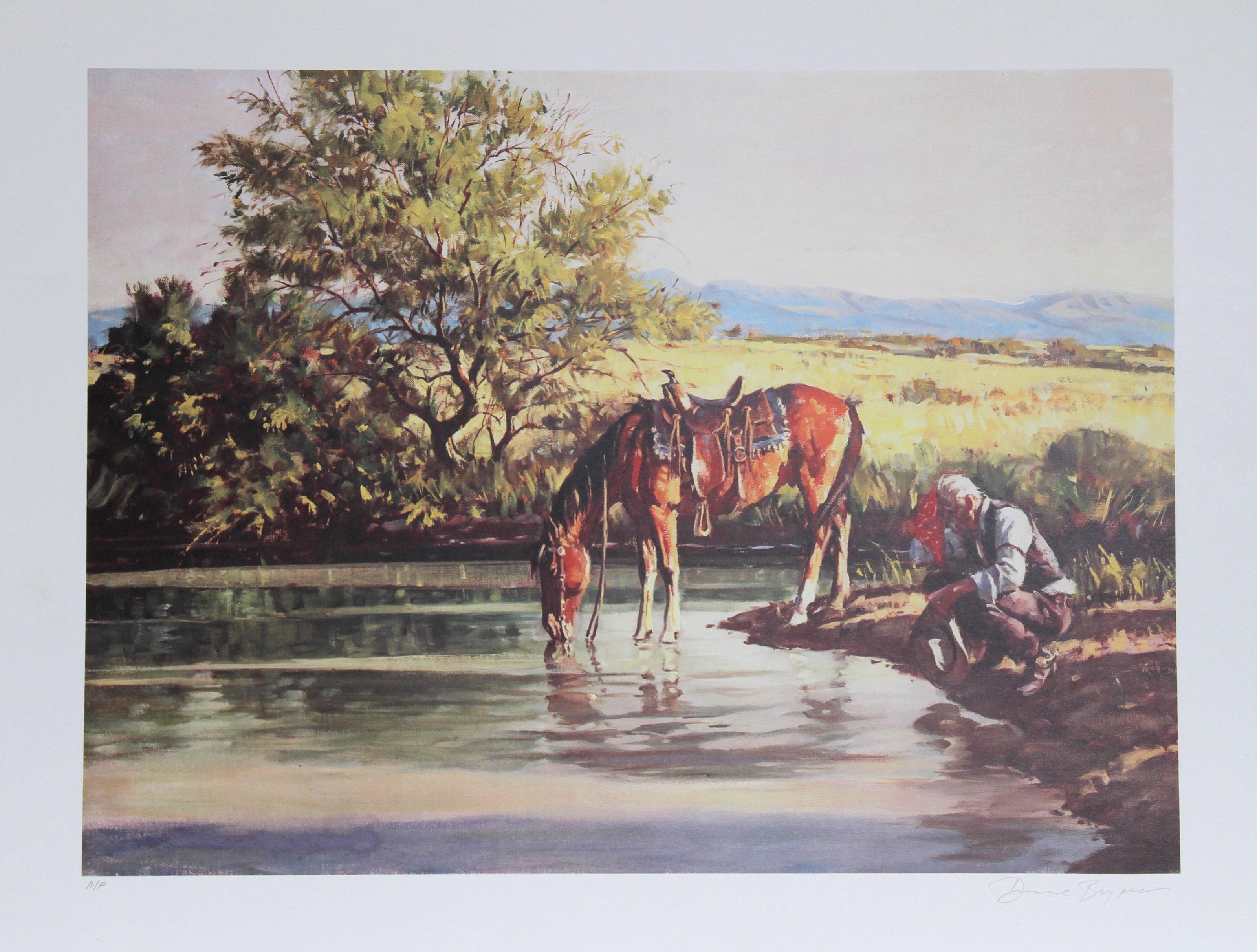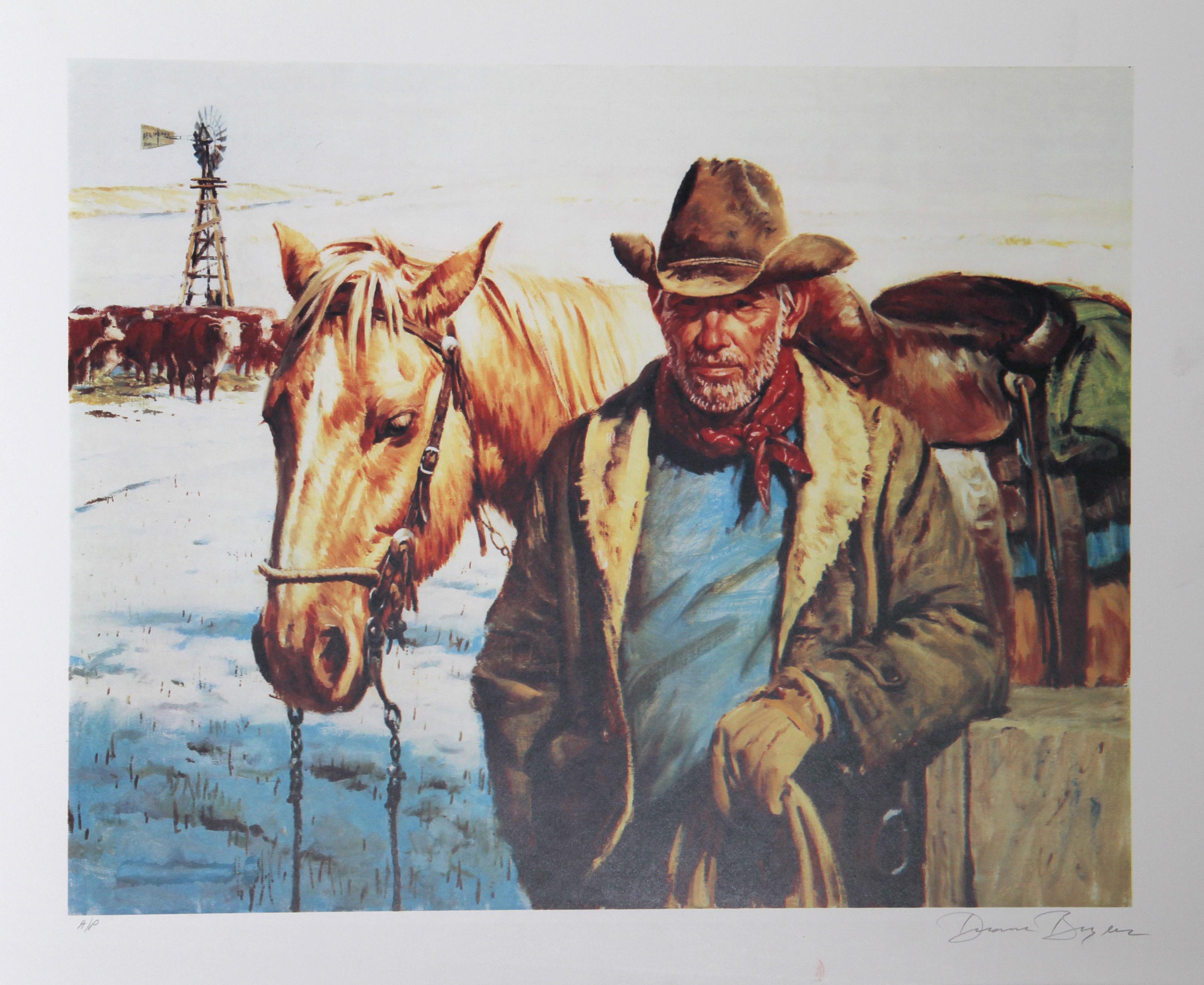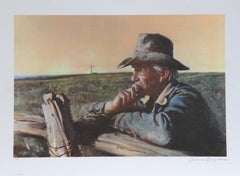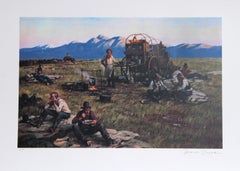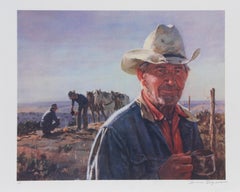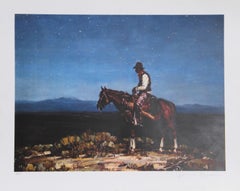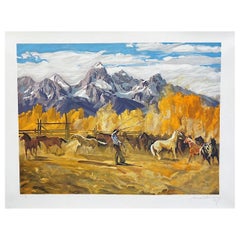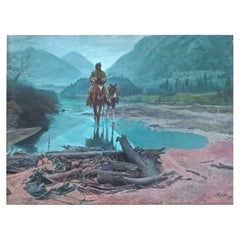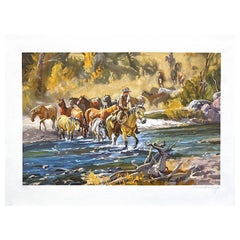Items Similar to Blue Harmonica, American Western Art Lithograph by Duane Bryers
Want more images or videos?
Request additional images or videos from the seller
1 of 6
Duane BryersBlue Harmonica, American Western Art Lithograph by Duane Bryers1979
1979
$500
£381.95
€438.82
CA$714.89
A$787.65
CHF 407.73
MX$9,483.45
NOK 5,162.88
SEK 4,850.20
DKK 3,276.65
About the Item
Duane Bryers, American (1911 - 2012) - Blue Harmonica, Year: 1979, Medium: Lithograph, Signed and Numbered in Pencil, Edition: 300, AP, Image Size: 17.5 x 22 in., Size: 21.5 in. x 29 in. (54.61 cm x 73.66 cm), Description: This rendering of several cowboys sitting around a campfire, one of whom is playing a harmonica, is highly similar to many other works by Duane Bryers. Set against the dusk sky, only the shadows of horses are visible, whereas the cowboys sitting around the fire have their faces illuminated by the light.
- Creator:Duane Bryers (1911 - 2012, American)
- Creation Year:1979
- Dimensions:Height: 21.5 in (54.61 cm)Width: 29 in (73.66 cm)
- Medium:
- Movement & Style:
- Period:
- Framing:Framing Options Available
- Condition:
- Gallery Location:Long Island City, NY
- Reference Number:Seller: RO16431stDibs: LU46616000332
About the Seller
4.9
Platinum Seller
Premium sellers with a 4.7+ rating and 24-hour response times
Established in 1979
1stDibs seller since 2014
3,128 sales on 1stDibs
Typical response time: 1 hour
- ShippingRetrieving quote...Shipping from: Long Island City, NY
- Return Policy
Authenticity Guarantee
In the unlikely event there’s an issue with an item’s authenticity, contact us within 1 year for a full refund. DetailsMoney-Back Guarantee
If your item is not as described, is damaged in transit, or does not arrive, contact us within 7 days for a full refund. Details24-Hour Cancellation
You have a 24-hour grace period in which to reconsider your purchase, with no questions asked.Vetted Professional Sellers
Our world-class sellers must adhere to strict standards for service and quality, maintaining the integrity of our listings.Price-Match Guarantee
If you find that a seller listed the same item for a lower price elsewhere, we’ll match it.Trusted Global Delivery
Our best-in-class carrier network provides specialized shipping options worldwide, including custom delivery.More From This Seller
View AllAll The Yesterdays, American Western Art Lithograph by Duane Bryers
By Duane Bryers
Located in Long Island City, NY
Duane Bryers, American (1911 - 2012) - All The Yesterdays, Year: 1979, Medium: Lithograph, signed and numbered in pencil, Edition: 300, AP, Image Size: 16 x 23.5 in., Size: 20.5...
Category
1970s American Realist Landscape Prints
Materials
Lithograph
His Family, American Western Art Lithograph by Duane Bryers
By Duane Bryers
Located in Long Island City, NY
Duane Bryers, American (1911 - 2012) - His Family, Year: 1979, Medium: Lithograph, Signed and Numbered in Pencil, Edition: 300, AP, Image Size: 14.5 x 22.5 in., Size: 21.5 in. ...
Category
1970s American Realist Landscape Prints
Materials
Lithograph
Middle of Nowhere, American Western Art Lithograph by Duane Bryers
By Duane Bryers
Located in Long Island City, NY
Duane Bryers, American (1911 - 2012) - Middle of Nowhere, Year: 1979, Medium: Lithograph, Signed and Numbered in Pencil, Edition: 300, AP, Image Size: 16 x 23.5 in, Size: 20.5 i...
Category
1970s American Realist Animal Prints
Materials
Lithograph
Lonesome Train Whistle, American Western Art Lithograph by Duane Bryers
By Duane Bryers
Located in Long Island City, NY
Duane Bryers, American (1911 - 2012) - Lonesome Train Whistle, Year: Circa 1979, Medium: Lithograph, signed and numbered in pencil, Edition: 300, AP, Image Size: 17 x 22 in., Siz...
Category
1970s American Realist Landscape Prints
Materials
Lithograph
Along the Way, American Western Art Lithograph by Duane Bryers
By Duane Bryers
Located in Long Island City, NY
Duane Bryers, American (1911 - 2012) - Along the Way, Year: 1979, Medium: Lithograph, signed and numbered in pencil, Edition: AP, Image Size: 17 x 22.5 inches, Size: 21.5 in. x ...
Category
1970s American Realist Landscape Prints
Materials
Lithograph
Checking The Stock, American Western Art Lithograph by Duane Bryers
By Duane Bryers
Located in Long Island City, NY
Duane Bryers, American (1911 - 2012) - Checking The Stock, Year: 1979, Medium: Lithograph, Signed and Numbered in Pencil, Edition: 300, AP, Image Size: 18 x 22.5 inches, Size: 2...
Category
1970s American Realist Animal Prints
Materials
Lithograph
You May Also Like
SINGLIN' OUT Signed Lithograph, Rocky Mountain Landscape, Cowboy, Horses
By Conrad Schwiering 1
Located in Union City, NJ
SINGLIN' OUT by the American Western artist Conrad Schwiering, is a hand drawn limited edition lithograph printed using hand lithography techniques on archival Somerset paper 100% ac...
Category
1980s American Realist Animal Prints
Materials
Lithograph
Mort Kunstler (b. 1927) "Morning Mist" (1981) Oil on Canvas
By Mort Künstler
Located in Incline Village, NV
Painted in 1981, this iconic image of a trapper riding through a pond in the early morning hours of a Pacific Northwest setting is featured, and is the frontispiece for Dee Brown's book "Images of The Old West" (see images). It also appeared on the cover of the Saturday Evening Post Jan/Feb 2017 (see image), along with an article about the author who at 93 years of age is still active. A copy of that magazine autographed by the author is included with the sale of the painting.
Mort Kunstler...
Category
Vintage 1980s American Other Paintings
Materials
Canvas
EASIN' EM HOME Signed Lithograph Western Landscape Cowboy Crossing River, Horses
By Conrad Schwiering 1
Located in Union City, NJ
EASIN' EM HOME by the American Western artist Conrad Schwiering, is a hand drawn limited edition lithograph(not a photo reproduction or digital print) printed using hand lithography ...
Category
1980s American Realist Animal Prints
Materials
Lithograph
When the Land was His
Located in San Francisco, CA
This artwork titled "When the Land was His" 1985, is a color offset lithograph by renown western artist Arnold Friberg, 1913-2010. It is hand signed and...
Category
Late 20th Century American Realist Figurative Prints
Materials
Lithograph
Bomber and Buckeroos by Till Goodan, Westward Ho Company
Located in Phoenix, AZ
Bomber And Buckeroos ca. 1939
Till Goodan
Offset Lithograph
PRINTS ARE IN GOOD CONDITION. PRINTS MAY HAVE SMALL FLAW ALONG EDGE OF PAPER, DOES NOT EFFECT THE PRINT IMAGE
All the prints are 26 x 31 inches, Mustang Peeler, Bombers and Buckaroos, The stranger, Guardians of the Range and Range Baby.
Note that “The Mustang Runner” is 3 inches shorter in height, 23 x 31 inches
The print by Till Goodan was originally a painting and reproduced by the Westward Ho company as a set. Westward Ho produced the most sought after Western dinnerware ever made. The most popular pattern was the Rodeo pattern by Till Goodan. He Illustrated and branded many accessories sold by the Westward Ho Company.
Tillman Parker Goodan 1896-1958
To the casual observer his paintings are exciting and colorful. To the scholars of the Western Era they are benchmarks of authenticity. Such is the style of Till Goodan. He was born Tillman Parker Goodan in Eaton, Colorado on March 27, 1896. His father was a true western pioneer, mayor of Eaton, publisher of its first newspaper, and County Commissioner for several years.
After moving to California in 1905 and settling on a little farm that bordered the Michel Cattle Ranch, Till spent much of his boyhood with the Michel sons working on their ranch. There he developed his expertise as a calf roper and the skills of a working cowboy.
As a young man Till pursued endeavors that would initially callous his emerging artistic hands. He worked for the famous Miller and Lux Ranch in California. He packed mules and ran pack trains into the Sierra Mountains. He broke horses and competed in local rodeos riding saddle broncs and roping calves. And during the quiet hours he would draw pictures of ranch life and the action of the rodeo. People began commenting on his talents as an artist.
In 1917 he left the rodeo circuit and turned his full attention to a career in art. He studied with Roger Sterrett, William Paxton, and Dana Bartlett, all highly respected California artists. Till soon became a free-lance commercial artist doing work for Grauman’s Chinese and Lowe’s Theaters, Helms Bakery and Security Bank. He later assumed a position as Art Director for the Richfield Oil Company. However, his first love was still the art of the old west, horses, cowboys, and ranching. So, he left Richfield and gave his full attention to the field of fine arts.
He did oil painting, water colors and lithographs. He drew the Gene Autry Comic Books. He illustrated and hand lettered a large collection of stories about famous bucking horses, ranches, horsemen of the world, and western gear. In association with W.C. Wentz, he started producing a complete line of western gift wares, ceramics, bronzes, leather, paper, and fabric.
By the 1930′s he was beginning to receive recognition for his western art and by the early 1940s, he and his daughter, Betty, were illustrating comic books for his longtime friend, Gene Autry. Betty was also a world champion cowgirl.
Till Goodan designs appeared in virtually every medium. But, the most famous was the four lines of dinnerware produced by Wallace China...
Category
1930s American Impressionist Figurative Prints
Materials
Lithograph
Playing the Harmonica, Saturday Evening Post Cover
By Eugene Iverd
Located in Fort Washington, PA
Signed Lower Right by Artist
Saturday Evening Post Cover, October 6, 1934
Category
1930s Paintings
Materials
Oil
More Ways To Browse
Leroy Neiman Serigraphs Sailing
Lilian May Miller
Lionel Lindsay
Maine Woodcut
Mammoth Ski Poster
Marco Sadeler
Mary Teichman
Monet Etching
Orchard By David Harrison
Oscar De Mejo
Pablo Picasso Original Inc Sketch
Paul Baum
Paul Emile Lecomte Etching
Paul Pedulla
Peter De Pannemaeker
Peter Max Boat
Pierre Maulin
Rene Eugene Lairy
